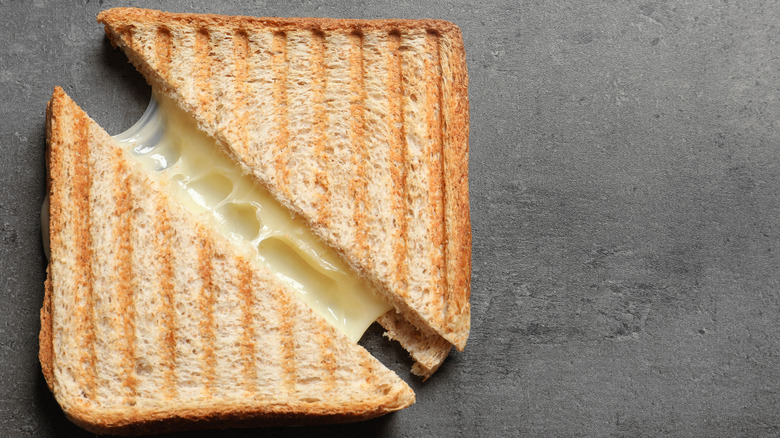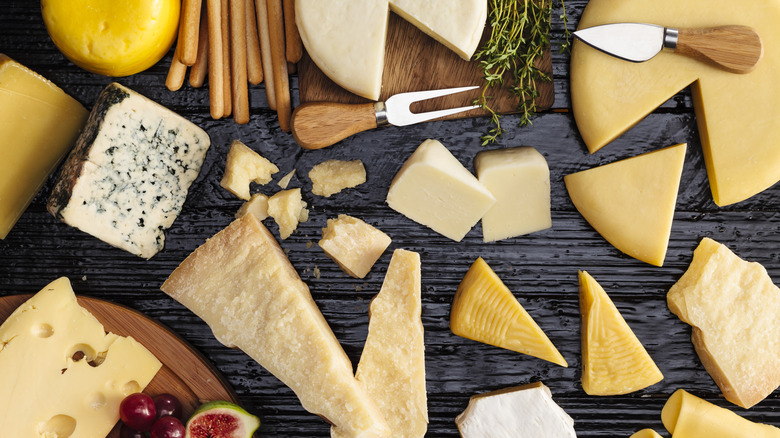The Flavorful Combo Alton Brown Swears By For Grilled Cheese
Making the most ooey-gooey grilled cheese may be a form of art, but there's science involved in creating a grilled cheese masterpiece, too. Who, then, could be better to turn to for tips on how to make the tastiest version of this simple sandwich than chef and food science extraordinaire Alton Brown?
In his video featuring Grilled- Grilled Cheese, Brown shares how to make what he considers to be a version of grilled cheese that more authentically fulfills the sandwich's name by actually grilling both the bread and the cheese separately, then the bread and the cheese together, on a charcoal grill. For this version, Brown specifies that he wants to achieve a grilled cheese that is simultaneously nutty and sharp as well as super melty — for that, he recommends using Gruyère and extra sharp cheddar.
Brown has said that, sure, you can use only one cheese when preparing grilled cheese — but that mixing a combination of cheeses together can create just the right flavor and texture you're looking for. So what makes Gruyère and extra sharp cheddar a winning combination for grilled cheese? It comes down to the texture and blend of flavors.
Why you should use extra sharp cheddar and Gruyère
Extra sharp cheddar is fairly commonplace, so its accessibility is certainly working in its favor when it comes to using it for grilled cheese. Plus, the 18-24 month aging process helps to build the sharp flavor that Brown was looking for in his particular grilled cheese.
Gruyère isn't necessarily rare, but depending on your region or the grocery store, it may be a little more challenging to find or less prominently displayed. This semi-hard cheese hails from Switzerland, and its unique nuttiness is attributed to the natural diet of the cows in the pastures of the Fribourg Prealps. When a true Gruyère is hard to find, you can substitute Emmentaler, Comte, or American-made alpine-style cheese to impart nutty flavor into the sandwich. When combined with the cheddar, this style of cheese balances the sharpness with its more earthy flavor and delicate finish.
The texture of these two cheeses when melted is just as important as the flavor. When Brown laid out what characteristics he was looking for in the cheeses, in addition to nuttiness and sharpness, he also stated that he wanted them to have a "high gooeyness factor." Both of these cheeses are known for their ability to melt well — Gruyère is a favorite for fondue and French onion soup, and both are solid choices for mac and cheese as well.
Why do these cheeses melt so well?
When it comes to getting that perfect cheese pull, it all comes down to calcium and pH levels in the cheese. Calcium is responsible for holding the structure of the cheese together while the pH level affects how effectively calcium does that.
In the cheesemaking process, bacteria, enzymes, and sometimes rennet (or another acid like vinegar) are added to milk to create curds and contribute to the aging process. As cheese ages, those ingredients help to turn lactose into lactic acid, which lowers the pH. When the pH is down, the calcium in the cheese releases some of its hold on the casein, and — voila! — the cheese becomes able to melt well. But, there's a caveat — if the pH becomes too low, then it doesn't melt well at all. Instead, it separates, becoming oily and messy.
The ideal pH range for cheese that will give you a perfectly gooey grilled cheese is 5.3 to 5.5. Cheddar cheese falls in the range of 5.1 to 5.4 while Gruyère falls between 5.5 and 5.7, making them both ideal for grilled cheese. Others with similar pH levels include manchego and Colby, as well as some of Brown's other favorites, gouda and asiago.
So, Brown's recommendations for pairing extra sharp cheddar and Gruyère are clearly rooted in science — though you can also mix and match other cheeses as well. Just be sure to follow his other advice: Grate your own cheese instead of buying it shredded. Oh, and make sure the pH is at the perfect level for ooey gooey grilled cheese.



